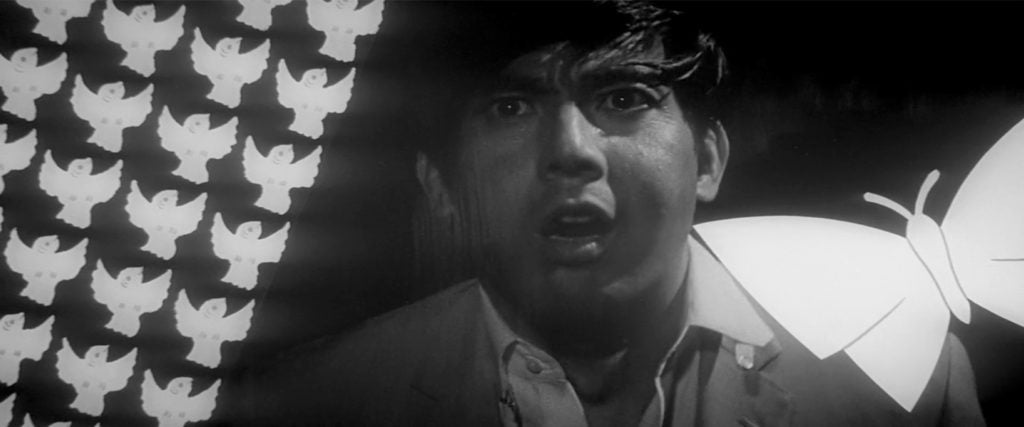With more and more movie streaming services popping up, it can feel impossible to keep track of what’s showing where. So to help, this October I’ll be recommending a different film every day from one such service that embodies the spooky spirit of the season. From classic Halloween movies to indie horror to campy dark comedies, this is 31 Days of a Very Chingy Halloween.
Today I’m looking at Branded to Kill, Seijun Suzuki’s delirious yakuza thriller, available to stream on Criterion Channel.
Goro Hanada (Joe Shishido) is Number 3, the third-highest ranked hitman in Japan’s criminal underworld. On his way back from a mission, he’s entranced by a mysterious woman named Misako who states that her only wish is “to die.” Misako gives Hanada a high-level assignment that he ultimately fails when a butterfly lands on the scope of his rifle. He’s subsequently exiled from the yakuza with a contract put out on his life. The pressure from the constant threat of assassination combined with his all-consuming attraction to this suicidal vixen (who is also trying to kill him) begin to wear on Hanada’s grip on reality, with his sanity steadily deteriorating as he attempts to survive the ordeal.
The thing about attempting to synopsize Branded to Kill is that a brief description of the major events that occur doesn’t begin to cover what makes this film so cacophonously creative and nonsensically brilliant. For instance, giving you story beats doesn’t even let you know the pivotal detail of Hanada’s character — that he huffs the smell of boiled rice like a bottle of poppers to get aroused. It doesn’t elucidate a scene in which Hanada reaches for his enigmatic paramour’s pussy and only comes up with two hands full of dead butterflies. Branded to Kill not only defies categorization; in many ways, it defies explanation as well.
By his own claim, Seijun Suzuki was a filmmaker whose movies “make no sense and make no money.” From 1956 to 1967, Suzuki directed 40 films for the Japanese film studio Nikkatsu. Primarily given B-movies to work on — exceptions include the sex-driven post-war drama Gate of Flesh, again starring Shishido in a role where he seemingly killed a real cow on-screen — Suzuki set himself apart from the other directors in the studio’s stable with a heavy emphasis on style. Unwilling to be a journeyman in a rigid system, his filmmaking technique was playful, carrying a disdain for realism and a tendency toward the abstract, with his characteristically bold imagery (e.g., rooms full of preserved lepidoptera, sudden hand-drawn overlays on live footage) creating a sense of surrealism (Suzuki claims this wasn’t intentional).
When Suzuki made Branded to Kill for the studio as a favor, he was ultimately wrongly fired for the final product (the studio was attempting to cover up their own financial losses by scapegoating an odd film) and was unable to make another film for a decade. Today, the movie is lauded as his magnum opus, a masterpiece of aesthetic absurdism that’s influenced filmmakers like Quentin Tarantino and Jim Jarmusch. Here again, he eschewed a straightforward yakuza story for progressively more delirious cuts and imagery, transporting us into the perspective of Hanada. The primary theme of the film seems to be obsession, with Hanada’s life falling further and further apart because of his need for the suicidal femme fatale Misako.
In essence, Branded to Kill is about wanting goth girl pussy so bad you accidentally ruin your life over it, and who among us can’t relate to that?
To see a list of each of the previous entries, check out the A Very Chingy Halloween list on Letterboxd.

